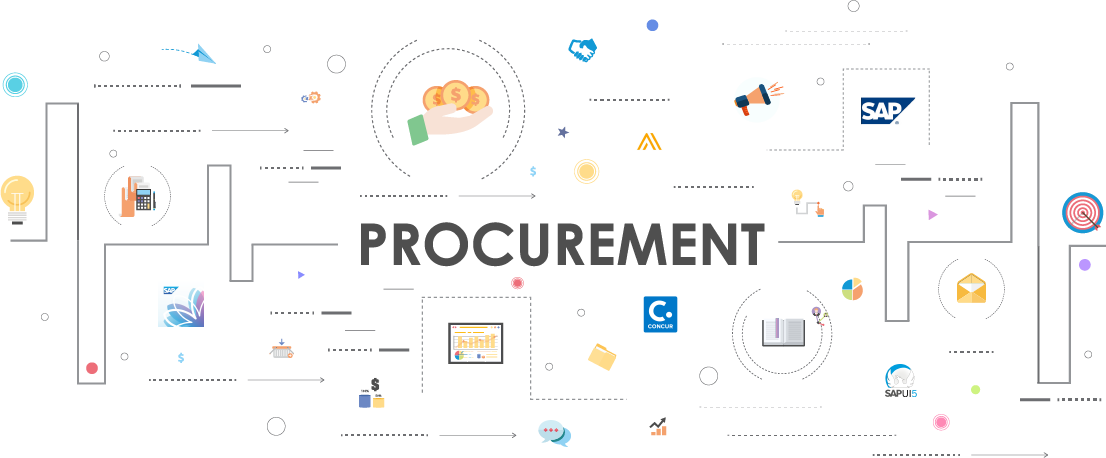Procure-to-pay is a major part of our work at ExceleratedS2P.
We help our clients optimize their procure-to-pay processes, using the most powerful enterprise solutions, including SAP and SAP Ariba.

But what exactly is procure-to-pay software?
The term procure-to-pay may be unfamiliar to people working in procurement because it is a term invented by the software industry to encompass the gamut of processes and activities involved in buying raw materials, goods and services.
This flow includes identifying suppliers, negotiating contracts, raising requisitions, approving and placing orders, receiving goods, processing invoices, making payments, reviewing supplier performance and compliance, and monitoring the performance of procurement in general.
As you can see, there are many activities going on behind the scenes. Even a simple purchasing transaction can involve multiple touchpoints, several stakeholders and various processes.
This complexity is one reason why organizations invest in a dedicated procure-to-pay solution. By taking control of this activity, organizations can reduce spending, increase compliance and spend less time managing routine tasks. It can be a way to control costs and become a more effective procurement team by buying the most appropriate resources from the most trusted suppliers.
Procurement plan
Underpinning any procurement team should be a procurement plan.
This should establish the strategy that guides all activity, defining things like spending limits, department budgets, timelines, stock levels, approvals, spending policies, preferred vendors, secondary (or plan B) vendors, and an approach to dealing with ad-hoc and unplanned spending, such as a last-minute requirement for gifts to hand out on a trade stand.

Procure-to-pay process
A typical procure-to-pay process includes many steps:
1. Requisition. A colleague identifies a need for materials or services and creates a requisition.
2. Vendor selection. This might include a request for proposals (RFP) unless a preferred supplier has already been identified.
3. Purchase order. Once the vendor has been selected, a purchase order (PO) is sent, requesting a quantity of goods or services at a defined price. Business rules may define which personnel can approve purchase orders, depending on their value.
4. Goods received. When the materials are received, they are booked into the system and marked against the purchase order.
5. Invoice received. The supplier sends an invoice (typically by post or email). This is entered into the P2P system and logged against the purchase order and goods received.
6. Approval. Once the invoice is matched against the PO, it will be reviewed by the appropriate stakeholder to ensure it complies with company policies and is within agreed limits.
7. Payment. The invoice can now be queued for payment.
As you can see, this end-to-end process includes many stakeholders, both internal and external. Without a single software solution to manage all of this, it is impossible for organizations to know that they are spending the right amount with the right suppliers.
Challenges of procure-to-pay
Procurement is a challenging business function. When it’s done well, it can be almost invisible; the right goods are received, just in time, for the right price. The business has everything it needs to operate, and very little is wasted.
But achieving this zen-like procurement operation takes a great deal of work. And getting to this stage of maturity requires organizations to overcome the intrinsic challenges of procurement:
Time-consuming
Without technology to streamline processes and eliminate manual processes, procurement is a very time-consuming function. Teams of procurement professionals can be occupied with the routine tasks of issuing orders, gathering proposals, chasing approvals, resolving queries and inputting data manually.
These time-consuming tasks can lead to overworked procurement teams, and an inability to focus on strategic goals.
Lack of visibility
With orders scattered across numerous desks and contained in a blend of paper and digital forms, there is no simple way to take a snapshot of spending, or of pending orders. The business cannot definitively forecast their cashflow.
Out of control spending
Without comprehensive controls, spending can spiral out of control. When procurement systems are difficult to use, colleagues are more likely to find workarounds, using their own cash or a company credit card to make ad-hoc purchases. This means that less spending is compliant with company policies, and the organization is likely to miss out on opportunities to consolidate spending – and save money.
Fraud
If a single individual can create, edit and approve transactions, then your business is exposed to an unacceptable degree of fraud risk. Other risks exist in procure-to-pay, particularly when the organization has little oversight over purchasing activity. Slow and convoluted processes make it harder for management to review a snapshot of procure-to-pay activity.
Procure-to-pay software – the solution to your challenges?
While we’ve only outlined a few of the challenges faced by procurement teams, it’s easy to see why companies would seek a dedicated procure-to-pay solution.
It’s worth noting that many companies rely on their ERP or accounting software to manage P2P, but over time this approach becomes unsustainable, primarily because the software does not truly manage the entire process, nor does it offer any of the automation or optimization features that procurement teams need to remain competitive.
With a dedicated P2P solution, procurement can elevate their operations from the transactional to the strategic.
Automate procure-to-pay
Procure-to-pay software often seeks to streamline the flow of information between buyers and sellers. Instead of sending purchase orders by email, for example, a P2P solution can transmit orders directly to the supplier, and then also accept invoices automatically, which can then be matched against the goods received note, and the PO, with minimal interaction from the accounts payable team.
Some P2P platforms offer catalogue buying, so employees can identify goods from an approved catalogue that is populated with items from preferred suppliers. This makes it faster and easier for colleagues to requisition goods and ensures that more spending complies with company policies.

Optimize procure-to-pay
Another key advantage of dedicated procure-to-pay solutions is the ability to monitor spending, learn from mistakes, and gradually move towards a strategic approach to supplier selection and management.
Want to know more about procure-to-pay software?
At ExceleratedS2P, we help companies like yours to choose the right P2P solutions, implement them rapidly and ensure your entire team experiences the full potential of your investment.
Our experience includes high street banks, major car manufacturers and leading fashion houses, and our locations in New York, London and Melbourne enable us to support global organizations with the most challenging procurement environments.
If you want to know how technology can transform your procurement operation, or how your existing software can work harder, then contact our consultants today.

Recent Comments